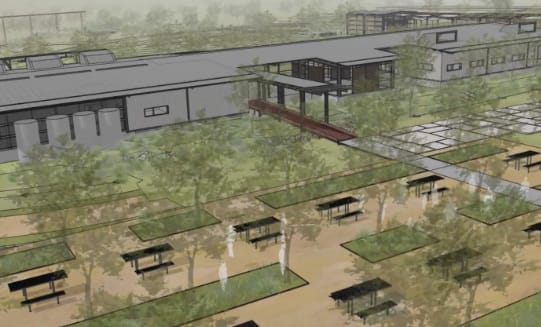
NBU & Headwaters at the Comal
The Comal River is the heart and soul of the New Braunfels area and for thousands of years it has been an important gathering place for people. The Comal River and the springs that feed it are core to the identity of the New Braunfels community and are a critical natural resource for the region. To ensure the conservation of this natural resource, New Braunfels Utilities (NBU) established the Headwaters at the Comal non-profit organization in 2017, and together, they work to inspire the lifelong practice of experiencing, enjoying, and stewarding the cultural, ecological, and community resources that make New Braunfels and the Hill Country region a special place to live.
Community Vision
In 2012, NBU and its design team, led by Lake|Flato Architects, held stakeholder engagement and site master planning processes which provided community-driven direction for the project. Beginning in 2017, Headwaters began leading the grand metamorphosis; the complete transformation of this 16-acre site from an old utility and facilities property that sits at the headwaters of the Comal River into the Hill Country’s premier education and community center.

This site is the location of the headwater springs of the Comal River and the first waterworks property owned by the City of New Braunfels.
Historically, the immediate area possessed fine, high quality sedimentary rock for fashioning stone tools; pure water; lush vegetation; and an abundance of game. Thus, native tribes were attracted to the Comal River and its surrounding springs as far back as 10,000 years.
2012
In 2012 New Braunfels Utilities convened a group of community stakeholders to engage in providing a direction for the then unused buildings and spaces surrounding the working water plant, called the Comal Springs Conservation Center. These efforts resulted in the vision to restore the property to a world class environmental education center highlighting the cultural and environmental significance of the Comal Springs, the largest springs system west of the Mississippi.




2014
2014 saw the completion of the Comal Springs Conservation Center Master Plan. The plan formalized the Community Vision for the property and created was adopted by New Braunfels Utilities for implementation.
2016
Ground-breaking ceremony held for Phase I site development which included removal of five acres of asphalt and replacement with hundreds of native trees, plants, and grasses, scenic walking trails and interpretive signage; significant riparian zone restoration on the Comal River; daylighting the headsprings of the Comal River; and remodeling an old warehouse building into a beautiful learning pavilion. Site build out activities resulted in a dramatic 94% reduction in localized pollution entering the Comal River system.
2017
The Headwaters at the Comal non-profit organization received IRS 501c3 tax exemption status. The non-profit board was established and monthly meetings to create a sustainable long-term vision for the project began.
2018
As a result of extensive finds of cultural deposits discovered during the first phase of restoration efforts a researched archaeological excavation begins at three different locations on the site. Visit our “Excavation Journal” link to find an in-depth analysis of the 6-month excavation. Work is on-going to develop on-site learning and displays highlighting this unique and rare opportunity to share Texas history at its source.
2019
Strategic plan created by Headwaters board of directors. Focus on partners and funding for continued development of the project plan in order to execute on 4 pillars of Educate & Demonstrate; Protect & Conserve; Partner in Research; Create Community. Headwaters continues to expand programs and events inspiring visitors to learn to live in balance with and benefit from an understanding and appreciation of nature and history.
1959
The operations of the city’s waterworks were turned over to New Braunfels Utilities (NBU) in 1959 and the utilities moved their operations to the Klingemann property in the 1960s. Operations remained there until 2004, when NBU moved their water and electric operations, along with a number of other departments, to a new location on FM 306.
1944
By 1936, the spring had been capped and two stone and concrete buildings were constructed to house water pressurization equipment, maintenance facilities, and a metal foundry. These rock buildings still remain on the property. At least two wells were in operation in 1936, with a third drilled in December 1944.
1936
The mayor reported in the City Council meeting minutes from 1936 “that the State Health Dep’t. had recommended that the City incase with concrete its main spring water supply at the pumping plant in order to eliminate the possibility of contamination from surface waters seeping in the present concrete block walled spring.”
1933
The City of New Braunfels applied for newly available Federal funding for improvements at the city waterworks in 1933. With that funding, the city set about cleaning up the property. Improvements included “walling up” (capping) the springs to help control flow, clearing out underbrush, and constructing new buildings.
1906
Friedrich “Fritz” Heinrich Klingemann, having inherited his father’s property at Klingemann Springs, offered to sell the spring property to the city in 1906 for $2,000. The city council rejected the offer, feeling it was too high for what they deemed an “alligator swamp.” Eventually, the city purchased the land for an increased price of $2,500 in 1907. Soon new water lines and a pump were installed on the property, founding the city’s new waterworks.
1846
The springs were just as important in terms of survival to the Europeans who arrived later to the area. Johann Heinrich Klingemann emigrated with his family from Hanover, Germany, to New Braunfels in 1846 and purchased the land surrounding the uppermost springs of the Comal River. These springs (three in total) came to be known by locals as the Klingemann Springs.
Up to the early twentieth century, New Braunfels relied on the Comal River for its water supply, pumping it out from the river near the Clemens Dam. The textile mills and general city growth began polluting the river at the turn of the century, and the city turned to cleaner sources upstream.



